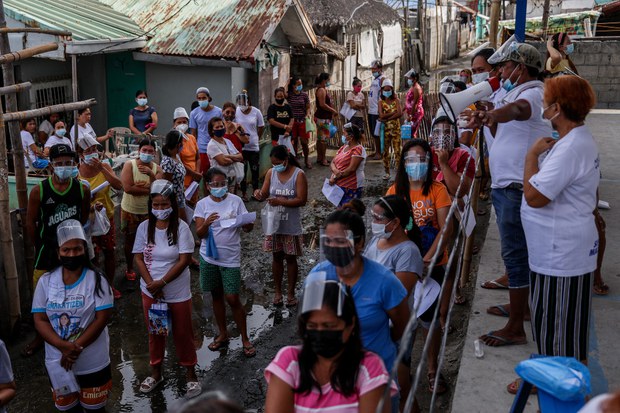ADB Predicts Regional Economic Growth despite COVID-19
2021.04.28
Manila
 Philippine residents line up to claim financial aid in Tibaguin, a small village north of Manila, April 20, 2021.
Philippine residents line up to claim financial aid in Tibaguin, a small village north of Manila, April 20, 2021.
Developing economies in Asia are forecast to rebound this year after contracting in 2020 amid the global COVID-19 outbreak, but the outlook depends on how fast governments can roll out vaccines, the Asian Development Bank said Wednesday.
ADB’s projected growth of 7.3 percent for the entire region is higher than its 6.8 percent forecast last December, the Manila-based multilateral lending agency said in releasing its Asian Development Outlook report. The outlook for 2022 is expected to cool to 5.3 percent.
“The biggest risk to recovery is still the pandemic,” ADB chief economist Yasuyuki Sawada told a virtual news briefing. “New outbreaks continue, in part due to new variants. And many Asian economies face challenges in procuring and administering vaccines.”
ADB forecast the Philippine economy would grow by 4.5 percent this year and 5.5 percent in 2022. While the 2021 growth falls below the regional forecast, it is a turnaround from 2020 when the economy contracted by 9.6 percent.
Elsewhere, ADB projected the economy to grow 4.5 percent this year and 5.0 percent in 2022 in Indonesia; 6.0 percent and 5.7 percent in Malaysia; and 3.0 percent and 4.5 percent in Thailand. Like the Philippines, all three nations saw their economies shrink in 2020.
The projected growths are in line with ADB’s forecast for Southeast Asia.
In a separate document highlighting findings in the outlook report, ADB forecast growth in the region at 4.4 percent in 2021 and 5.1 percent in 2022.
“Vaccination programs and expansionary monetary and fiscal policies are expected to underpin the revival of domestic demand. Both factors are becoming evident in Malaysia and Singapore, two closely intertwined economies that are benefiting from accommodative financial policies, and in Indonesia,” the highlights statement said.
“In the Philippines, fiscal stimulus from spending on infrastructure and social assistance will promote a bounce back,” it said.
In South Asia, ADB projected Bangladesh’s economy to grow 6.8 percent this year and 7.2 percent in 2022. Dhaka’s economy grew 5.2 percent in 2020.
COVID-19 outbreaks
In an effort to slow the spread of the coronavirus within its territory and facing a shortfall from India, the government of Bangladesh approved a proposal to produce the Chinese Sinopharm and Russian Sputnik vaccines locally, Finance Minister A.H.M. Mustafa Kamal said on Wednesday.
Bangladesh has recorded more than 754,000 infections and more than 11,300 deaths since the pandemic began, according to disease experts at U.S.-based Johns Hopkins University.
Among those infected is opposition leader and three-time Prime Minister Khaleda Zia. The leader of the Bangladesh Nationalist Party was diagnosed on April 10 and admitted to a private hospital for medical exams on Tuesday night, party Secretary Gen. Mirza Fakhrul Islam Alamgir told BenarNews.
“Madam underwent some necessary medical examinations and she has been in good health. The doctors will examine the reports and decide whether she would need to stay at the hospital or return to her house,” he said.
Lawmakers themselves are not immune – more than 100 of the total 350 members of parliament have been infected, Speaker Shirin Sharmin Chaudhury told BenarNews. Of that number, at least four have died – Abdul Matin Khasru, Mahmud Us Samad Chowdhury, Mohammad Nasim and Israfil Alam.
Other Bangladeshi politicians who have died of COVID-19 complications include State Minister for Religious Affairs Sheikh Abduallah, Attorney Gen. Mahbubey Alam and Defense Secretary Abdullah Al Mohsin Chowdhury.
Meanwhile in Manila, Sawada pointed to fresh spikes in coronavirus infections across Asia, noting the Philippines and India, where the nation has set daily global records in recent days and trails only the United States in the number of positive cases.
The Philippine’s COVID-19 infection rate has surpassed the 1 million mark, with daily cases often topping more than 8,000 since last month.
The department of health reported 6,895 new infections and 115 deaths on Wednesday, bringing the totals since the pandemic began to 1,020,495 and 17,031, respectively.
ADB reported that the Philippines showed signs of recovery beginning in the first quarter of 2021. The government appeared to be in control until late March when COVID-19 variants caused the number of daily infections to skyrocket.
“The recovery in the Philippines is expected to be fragile,” the Outlook report said. “Uncertainties over the course of COVID-19 continue to weigh on household and business sentiment. Rising infections led to the reimposition of strict community quarantine in late March for two weeks in Metro Manila and some neighboring provinces.”
Sawada said ADB was also concerned about what he called “long-term scarring” to individual economies, leading to prolonged unemployment and business closures.
“Economies in the region are on diverging paths,” Sawada said. “Their trajectories are shaped by the extent of domestic outbreaks, the pace of their vaccine rollouts and how much they are benefiting from the global economy.”
In its section on the Philippines, the Outlook issued a warning for the region.
“The forecast comes with downside risks. The uncertain course of the COVID-19 pandemic and the possibility of more resilient coronavirus variants could hamper the recovery and weigh on confidence globally. Domestically, the vaccine rollout may suffer supply delays as wealthy nations have stockpiled vaccines and community quarantines could be prolonged to curb the spread of COVID-19,” it said.
Kamran Reza Chowdhury in Dhaka contributed to this report.







